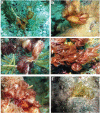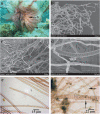Caldora penicillata gen. nov., comb. nov. (cyanobacteria), a pantropical marine species with biomedical relevance
- PMID: 26327714
- PMCID: PMC4551411
- DOI: 10.1111/jpy.12309
Caldora penicillata gen. nov., comb. nov. (cyanobacteria), a pantropical marine species with biomedical relevance
Abstract
Many tropical marine cyanobacteria are prolific producers of bioactive secondary metabolites with ecological relevance and promising pharmaceutical applications. One species of chemically rich, tropical marine cyanobacteria that was previously identified as Symploca hydnoides or Symploca sp. corresponds to the traditional taxonomic definition of Phormidium penicillatum. In this study, we clarified the taxonomy of this biomedically and ecologically important cyanobacterium by comparing recently collected specimens with the original type material and the taxonomic description of P. penicillatum. Molecular phylogenetic analyses of the 16S rRNA gene and the 16S-23S internal transcribed spacer regions showed that P. penicillatum formed an independent clade sister to the genus Symploca, and distantly related to Phormidium and Lyngbya. We propose the new genus Caldora for this clade, with Caldora penicillata comb. nov. as the type species and designate as the epitype the recently collected strain FK13-1. Furthermore, the production of bioactive secondary metabolites among various geographically dispersed collections of C. penicillata showed that this species consistently produced the metabolite dolastatin 10 and/or the related compound symplostatin 1, which appear to be robust autapomorphic characters and chemotaxonomic markers for this taxon.
Figures





Similar articles
-
Phylogenetic analyses of the genus Glaciecola: emended description of the genus Glaciecola, transfer of Glaciecola mesophila, G. agarilytica, G. aquimarina, G. arctica, G. chathamensis, G. polaris and G. psychrophila to the genus Paraglaciecola gen. nov. as Paraglaciecola mesophila comb. nov., P. agarilytica comb. nov., P. aquimarina comb. nov., P. arctica comb. nov., P. chathamensis comb. nov., P. polaris comb. nov. and P. psychrophila comb. nov., and description of Paraglaciecola oceanifecundans sp. nov., isolated from the Southern Ocean.Int J Syst Evol Microbiol. 2014 Sep;64(Pt 9):3264-3275. doi: 10.1099/ijs.0.065409-0. Epub 2014 Jun 30. Int J Syst Evol Microbiol. 2014. PMID: 24981324
-
Five chemically rich species of tropical marine cyanobacteria of the genus Okeania gen. nov. (Oscillatoriales, Cyanoprokaryota).J Phycol. 2013 Dec;49(6):1095-106. doi: 10.1111/jpy.12115. Epub 2013 Oct 21. J Phycol. 2013. PMID: 27007630
-
Neolyngbya gen. nov. (Cyanobacteria, Oscillatoriaceae): A new filamentous benthic marine taxon widely distributed along the Brazilian coast.Mol Phylogenet Evol. 2018 Mar;120:196-211. doi: 10.1016/j.ympev.2017.12.009. Epub 2017 Dec 13. Mol Phylogenet Evol. 2018. PMID: 29246815
-
Zarconia navalis gen. nov., sp. nov., Romeriopsis navalis gen. nov., sp. nov. and Romeriopsis marina sp. nov., isolated from inter- and subtidal environments from northern Portugal.Int J Syst Evol Microbiol. 2022 Oct;72(10). doi: 10.1099/ijsem.0.005552. Int J Syst Evol Microbiol. 2022. PMID: 36268793
-
Anti-Infective Secondary Metabolites of the Marine Cyanobacterium Lyngbya Morphotype between 1979 and 2022.Mar Drugs. 2022 Dec 7;20(12):768. doi: 10.3390/md20120768. Mar Drugs. 2022. PMID: 36547915 Free PMC article. Review.
Cited by
-
Advances in exploring the therapeutic potential of marine natural products.Pharmacol Res. 2019 Sep;147:104373. doi: 10.1016/j.phrs.2019.104373. Epub 2019 Jul 25. Pharmacol Res. 2019. PMID: 31351913 Free PMC article. Review.
-
Limnofasciculus baicalensis gen. et sp. nov. (Coleofasciculaceae, Coleofasciculales): A New Genus of Cyanobacteria Isolated from Sponge Fouling in Lake Baikal, Russia.Microorganisms. 2023 Jul 9;11(7):1779. doi: 10.3390/microorganisms11071779. Microorganisms. 2023. PMID: 37512951 Free PMC article.
-
Laucysteinamide A, a Hybrid PKS/NRPS Metabolite from a Saipan Cyanobacterium, cf. Caldora penicillata.Mar Drugs. 2017 Apr 14;15(4):121. doi: 10.3390/md15040121. Mar Drugs. 2017. PMID: 28420100 Free PMC article.
-
Marine-Derived Pharmaceuticals - Challenges and Opportunities.Biomol Ther (Seoul). 2016 Nov 1;24(6):561-571. doi: 10.4062/biomolther.2016.181. Biomol Ther (Seoul). 2016. PMID: 27795450 Free PMC article. Review.
-
Diversity, Cyanotoxin Production, and Bioactivities of Cyanobacteria Isolated from Freshwaters of Greece.Toxins (Basel). 2019 Jul 25;11(8):436. doi: 10.3390/toxins11080436. Toxins (Basel). 2019. PMID: 31349572 Free PMC article.
References
-
- Bolhuis H, Severin I, Confurius-Guns V, Wollenzien UIA, Stal LJ. Horizontal transfer of the nitrogen fixation gene cluster in the cyanobacterium Microcoleus chthonoplastes. ISMEJ. 2010;4:121–30. - PubMed
-
- Cannone JJ, Subramanin S, Schnare MN, Collett JR, D’Souza LM, Du Y, Feng B, Lin N, Madabusi LV, Muller KM, Pande N, Schang Z, Yu N, Gutell RR. The Comparative RNA Web (CRW) site: an online database of comparative sequence and structure information for ribosomal, intron, and other RNAs. BMC Bioinformatics. 2002;3:1471–2105. - PMC - PubMed
-
- Castenholz RW. Phylum BX. Cyanobacteria. Oxygenic photosynthetic bacteria. In: Boone DR, Castenholz RW, Garrity GM, editors. Bergey’s Manual of Systematic Bacteriology. Springer; New York, USA: 2001. pp. 473–87.
-
- Castenholz RW, Rippka R, Herdman M. Phylum BX. Cyanobacteria. Subsection III. Form-genus VII. Lyngbya Agardh 1824 (sensu Anagnostidis and Komárek 1988) In: Boone DR, Castenholz RW, Garrity GM, editors. Bergey’s Manual of Systematic Bacteriology. Springer; New York, USA: 2001a. pp. 547–8.
Publication types
Grants and funding
LinkOut - more resources
Full Text Sources
Other Literature Sources
Molecular Biology Databases

